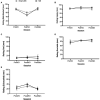Self-Rated Recovery and Mood Before and After Resistance Training and Muscle Microcurrent Application
- PMID: 35496154
- PMCID: PMC9046599
- DOI: 10.3389/fpsyg.2022.836695
Self-Rated Recovery and Mood Before and After Resistance Training and Muscle Microcurrent Application
Erratum in
-
Corrigendum: Self-rated recovery and mood before and after resistance training and muscle microcurrent application.Front Psychol. 2025 Jan 20;15:1544656. doi: 10.3389/fpsyg.2024.1544656. eCollection 2024. Front Psychol. 2025. PMID: 39902115 Free PMC article.
Abstract
Background: Resistance training (RT) can offer beneficial physiological and psychological effects. The regular continuation of this exercise can be accomplished by improving the recovery and mood after a workout. Frequency-specific microcurrent (microstimulation) might offer a solution here as it has been shown to improve physical injuries, mood state, and sleep. However, knowledge is lacking about the impact of microstimulation after RT on said parameters. The present study aimed to test the effects of RT and muscle-microstimulation on mood and physical recovery in healthy men after performing conventional deadlifts, which is a type of RT.
Methods: The study was conducted according to a single-blind, randomized, placebo-controlled, and two-way crossover study. Twenty participants naïve to microstimulation (MS) engaged in RT twice on separate days. They were randomized to receive MS on 1 day and no microstimulation (Sham-MS) on another day. Before and after the workout and after their treatment (MS or Sham-MS), participants self-rated their mood state and mental and physical exhaustion levels.
Results: Findings showed that MS increased the self-ratings of well-rested and sociable and, most importantly, reduced the feeling of exercise-induced exhaustion. There were no MS effects on ratings of feeling sad, happy, or exhausted, although the workout, independent of MS, negatively influenced the level of exhaustion.
Conclusion: The combination of enhanced sociableness, reduced fatigue, and exercise-induced exhaustion after a workout, followed by microstimulation, has important implications for professional sporters and nonprofessionals who try to get the best result after a workout. Future studies using a double-blind approach including different types of exercises, different durations of programs, and both sexes can shed more light on the full potential of microstimulation after a workout on mood state and exercise-induced exhaustion.
Keywords: deadlifts; frequency-specific microcurrent; microstimulation; mood; resistance training; self-rated recovery.
Copyright © 2022 Stößlein and Kuypers.
Conflict of interest statement
The authors declare that the research was conducted in the absence of any commercial or financial relationships that could be construed as a potential conflict of interest.
Figures




Similar articles
-
Corrigendum: Self-rated recovery and mood before and after resistance training and muscle microcurrent application.Front Psychol. 2025 Jan 20;15:1544656. doi: 10.3389/fpsyg.2024.1544656. eCollection 2024. Front Psychol. 2025. PMID: 39902115 Free PMC article.
-
Erratum.Mult Scler. 2016 Oct;22(12):NP9-NP11. doi: 10.1177/1352458515585718. Epub 2015 Jun 3. Mult Scler. 2016. PMID: 26041800
-
Effects of adding post-workout microcurrent in males cross country athletes.Eur J Sport Sci. 2021 Dec;21(12):1708-1717. doi: 10.1080/17461391.2020.1862305. Epub 2021 Feb 8. Eur J Sport Sci. 2021. PMID: 33295832
-
Novel Augmentation Strategies in Major Depression.Dan Med J. 2017 Apr;64(4):B5338. Dan Med J. 2017. PMID: 28385173 Review.
-
Behavioural modification interventions for medically unexplained symptoms in primary care: systematic reviews and economic evaluation.Health Technol Assess. 2020 Sep;24(46):1-490. doi: 10.3310/hta24460. Health Technol Assess. 2020. PMID: 32975190 Free PMC article.
Cited by
-
Effectiveness of Frequency-Specific Microcurrent (FSM) Therapy and Relaxation in Adults with Distress: A Pilot Randomized Controlled Trial.Healthcare (Basel). 2025 May 15;13(10):1151. doi: 10.3390/healthcare13101151. Healthcare (Basel). 2025. PMID: 40427987 Free PMC article.
-
Physiological effects of microcurrent and its application for maximising acute responses and chronic adaptations to exercise.Eur J Appl Physiol. 2023 Mar;123(3):451-465. doi: 10.1007/s00421-022-05097-w. Epub 2022 Nov 18. Eur J Appl Physiol. 2023. PMID: 36399190 Free PMC article. Review.
-
Bioelectric medicine: unveiling the therapeutic potential of micro-current stimulation.Biomed Eng Lett. 2024 Mar 11;14(3):367-392. doi: 10.1007/s13534-024-00366-3. eCollection 2024 May. Biomed Eng Lett. 2024. PMID: 38645592 Free PMC article. Review.
References
-
- Ahmed A. F., Elgayed S. S. A., Ibrahim I. M. (2012). Polarity effect of microcurrent electrical stimulation on tendon healing: biomechanical and histopathological studies. J. Adv. Res. 3, 109–117. doi: 10.1016/j.jare.2011.05.004 - DOI
-
- Cheng N., Van Hoof H., Bockx E., Hoogmartens M. J., Mulier J. C., De Dijcker F. J., et al. . (1982). The effects of electric currents on ATP generation, protein synthesis, and membrane transport of rat skin. Clin. Orthop. Relat. Res. 171, 264–272. doi: 10.1097/00003086-198211000-00045, PMID: - DOI - PubMed
-
- Cheung M.-C., Chan A. S., Yip J. (2015). Microcurrent stimulation at Shenmen Acupoint facilitates EEG associated with sleepiness and positive mood: a randomized controlled electrophysiological study. Evid. Based Complement. Alternat. Med. 2015:182837, 1–11. doi: 10.1155/2015/182837 - DOI - PMC - PubMed
-
- Cohen J. (2013). Statistical Power Analysis for the Behavioral Sciences. New York: Routledge.
LinkOut - more resources
Full Text Sources

